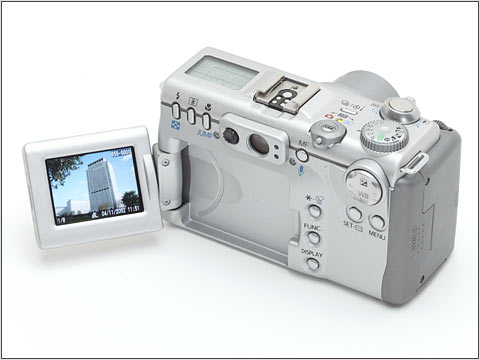De toonaangevende digicam-site DPreview heeft een zoals gebruikelijk uitgebreid verhaal geschreven over de PowerShot G3, de nieuwste 4 megapixel prosumer camera van Canon. Hoewel dit apparaat al enige maanden geleden werd aangekondigd kon men nu pas de hand leggen op een productie-exemplaar. De G3 is zuiniger met batterijen, heeft een sterkere zoomlens en een strakker, efficiënter design. De grootste verandering van het nieuwe model is echter de compleet nieuwe DiGiC processor en de bijbehoordende geavanceerde software. Er zijn dus veel meer instellingen mogelijk, en met features als iSAPS (Intelligent Scene Analysis based on Photographic Space) wordt mooie foto's maken makkelijker dan ooit.
De 24 pagina's tellende review is zoals gewoonlijk zeer grondig. Wie hem in zijn geheel doorleest wordt niet alleen haarfijn aan de hand van tabellen, grafieken, screenshots en foto's uitgelegd wat alle positieve en negatieve punten van het camera zijn, maar kan hem na afloop ook meteen bedienen. Er valt dus ontzettend veel te vertellen, maar de conclusie is duidelijk: Canon heeft de goede punten van de zeer populaire G2 meegenomen en daar een hele rits nieuwe features aan toegevoegd, waardoor ze nu met recht kunnen zeggen dat G3 de concurrentie in zijn klasse ver vooruit is. Er zijn zoals altijd wel een aantal negatieve punten aan te stippen, zoals een meer dan gemiddelde ruis op ISO 100, maar dat kan een "highly recommended" waardering met een gemiddeld cijfer van 8,9 niet in de weg staan. Hier een lijst met voor- en nadelen:
Pros:Cons:
- Excellent resolution, one of the best performances of a four megapixel
- Good metering, good tonal balance which maintains shadow detail
- Good natural light white balance, strong and balanced colours
- Control over cameras internal processing algorithms (saturation, tone, sharpness)
- Low noise at ISO 50, not as clean at ISO 100, more sensitive than rated value
- Good build quality, better overall design and control layout than the G2
- Shooting priority play mode (a half-press of the shutter release always returns to shooting)
- Excellent range of manual controls
- Good shot-to-shot times, startup time compromised by four second lens extension
- Superb fold-out and twist LCD, bright and assisted by anti-reflective coating
- Manual focus has magnified loupe and ruler readout
- Flexible continuous shooting modes (buffer after processing)
- RAW file format maintains 12-bits of data
- Ability to turn JPEG shot into RAW during record review
- Compact Flash Type I or II and official Microdrive support
- Flash hot-shoe, manual flash power, flash sync control (slow / curtain)
- Voice annotation feature
- Orientation sensor, although JPEG's are only tagged not rotated
- Built-in ND filter useful for bright outdoor / flash shots
- Intervalometer (time lapse)
- Excellent night exposures, should allow exposures longer than 15 seconds
- AF assist lamp works well
- Included Infrared remote control
- Superb battery life, the best we've seen of any prosumer digital camera
- Excellent included software suite including remote capture software with live viewfinder
- Good accessory support (quality wide angle and telephoto lenses, chargers, case)
- Some chromatic aberrations at or around maximum aperture
- Noise at ISO 100 worse than the competition
- 'Shallow angle jaggies' visible on resolution chart, although not yet seen in 'every day' shots
- Viewfinder partially obstructed by lens barrel
- Control dial doesn't work well if rotated too quickly
- Average macro performance
- No nine-point AiAF as seen in the PowerShot S45
- Zoom controller does not have enough steps / multiple zoom speed
- Status panel is not backlit
- Manual mode limits in relation to combinations of aperture and shutter speed (although better than the G2 and most other prosumer digital cameras)


:strip_exif()/i/998248528.jpg?f=thumbmedium)